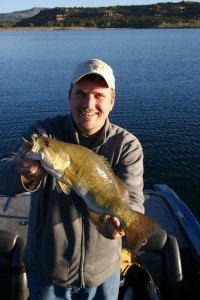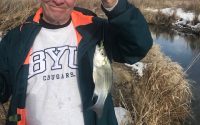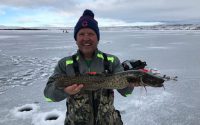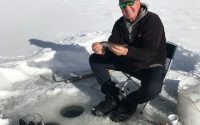Smallmouth Have A Very Healthy Spawn on Flaming Gorge

The crazy weather in the mountain states this spring delayed the spawning activities for all species of bass. In Flaming Gorge, only the smallmouth bass reside and they didn’t get started in earnest until the middle of June. And, as of today, July 10th, the spawn is still in full swing. Let’s take a look at why the smallmouth “spawn” in 2011 has been so productive and then, allow me to teach you a couple of secrets should you ever desire to catch a few smallies while they are on their beds.
First, let me say I have no problem catching and releasing fish preparing to spawn. What I object to is people who purposely wait for the spawn to catch and kill limits of smallmouth each day while they are tying to occupy their nests. it’s like shooting fish in a barrel and isn’t the least bit sporting. I urge you NEVER to do this. Too many states don’t have warm-water fisheries programs and if your state is anything like Utah, the Fish and Game department are responsible for the destruction of quality small and largemouth bass fisheries all over the state.
Smallmouth bass like a nighttime water temperature of at least 55 degrees before spawning in earnest. I’ve seen beds in 53-degree water but very few and only in the latter part of the day, when the sun is high and water is warming. In Flaming Gorge, even through the first week of July, the water levels in the reservoir were fairly stable, rising to be sure, but in a controlled way — a few inches a week. Smallmouth bass don’t have any problem spawning in water 15 to 18 feet deep as long as it is clear and the bottom is rocky enough to absorb as well as deflect heat from the sun. The spawning flats on the “Gorge” are just that way.
Though it was certainly a delayed spawn, the fish were able to do their business in relative private due to rising water. I found beds in 11 feet of water that, although several local and state bass tournaments were being held during this time, there were no anglers fishing these particular beds. And, the most surprising fact of all was that I was in an extremely popular spawning cove. So, the bass were able to spawn and leave without any fishing pressure.
That last observation about deep-spawning bass is the first of two “secrets” to catching spawning smallmouths that I promised to tell. If you are fishing on either side of the full or the new moon when the nighttime water temperatures are hovering around the 55 degree mark, don’t just look for beds in the 3 to 7 foot mark. Search much deeper and try to locate beds in water from 9 to 15 feet. The fish will be less pressured and will respond to baits much, much better.
The second secret is to take the time to understand what is going on in the tiny brains of each smallmouth as they pass through the spawning process. Each bass has its own mine, habits, and in short … personality. If the bass won’t stay on its bed, but circles the bed in a tight pattern, the fish can quite easily be caught by placing your bait directly on the bed and waiting for the fish to return. If the bass moves through the bed on a straight line and eventually returns to pass through the bed from the opposite direction, you may want to find other, more “ready” bass to target. Remember, take the time to watch and you’ll be rewarded with active fish to catch.
Since July 10th, the water level has gone up over five feet. The bass have mostly spawned now and are resting, getting ready to finally settle in to their summer pattern. What a great time to be fishing in northeastern Utah, on Flaming Gorge.










